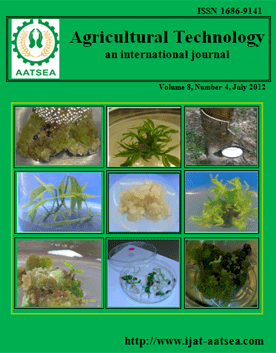ThaiScience
ThaiScience
INTERNATIONAL JOURNAL OF AGRICULTURAL TECHNOLOGY
Volume 14, No. 07, Month DECEMBER, Year 2018, Pages 1423 - 1432
Effective of neosatorya to control phomopsis asparagi causing stem blight of asparagus
Mangkalad, T., Soytong, K., Tangthirasunun, N. and Poeaim, S.
Abstract Download PDF
The biocontrol of stem blight of asparagus Phomosis asparagi was proved by Neosartorya and Talaromyces. The symptoms are appearance as oval-shaped lesions with light brown centres and slightly darker margins. Ten isolates of pathogen were isolated by tissue transplanting technique and confirmed by morphology and molecular identification based on internal transcribed spacer (ITS)-nrDNA sequence as P. asparagi. Fungal mycelia showed undulate margins and colonies white to gray and reached a diameter of 9 cm petri dish after 10 days. Alpha conidia were oblong or spindle-shaped, with a size of 2‒3.5 × 6.5‒8.8 μm. The fungal pathogenicity test showed the asparagus was infected by P. asparagi within 2 days on moisture chamber at room temperature. Neosartorya and Talaromyces were proved antifungal acrtivety against P. asparagi causing of stem blight of asparagus in dual culture. It revealed that N. hiratsuka EU06 was the highest inhibition P. asparagi causing the stem blight of asparagus at 59.50%.
Keywords
Stem blight, Phomosis asparagi, Neosartorya and TalaromycesINTERNATIONAL JOURNAL OF AGRICULTURAL TECHNOLOGY
Published by : Association of Agricultural Technology in Southeast Asia (AATSEA)
Contributions welcome at : http://www.ijat-aatsea.com
